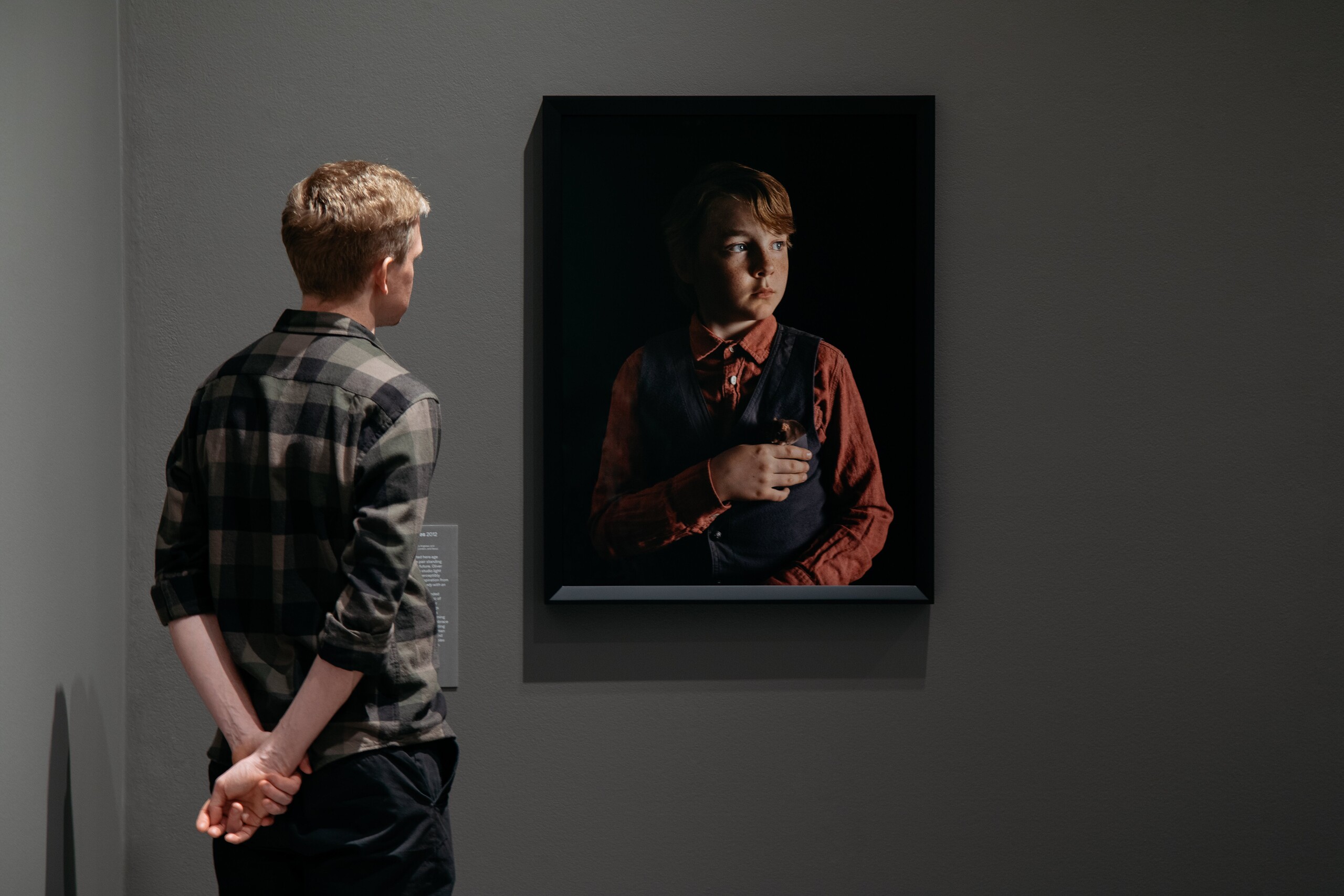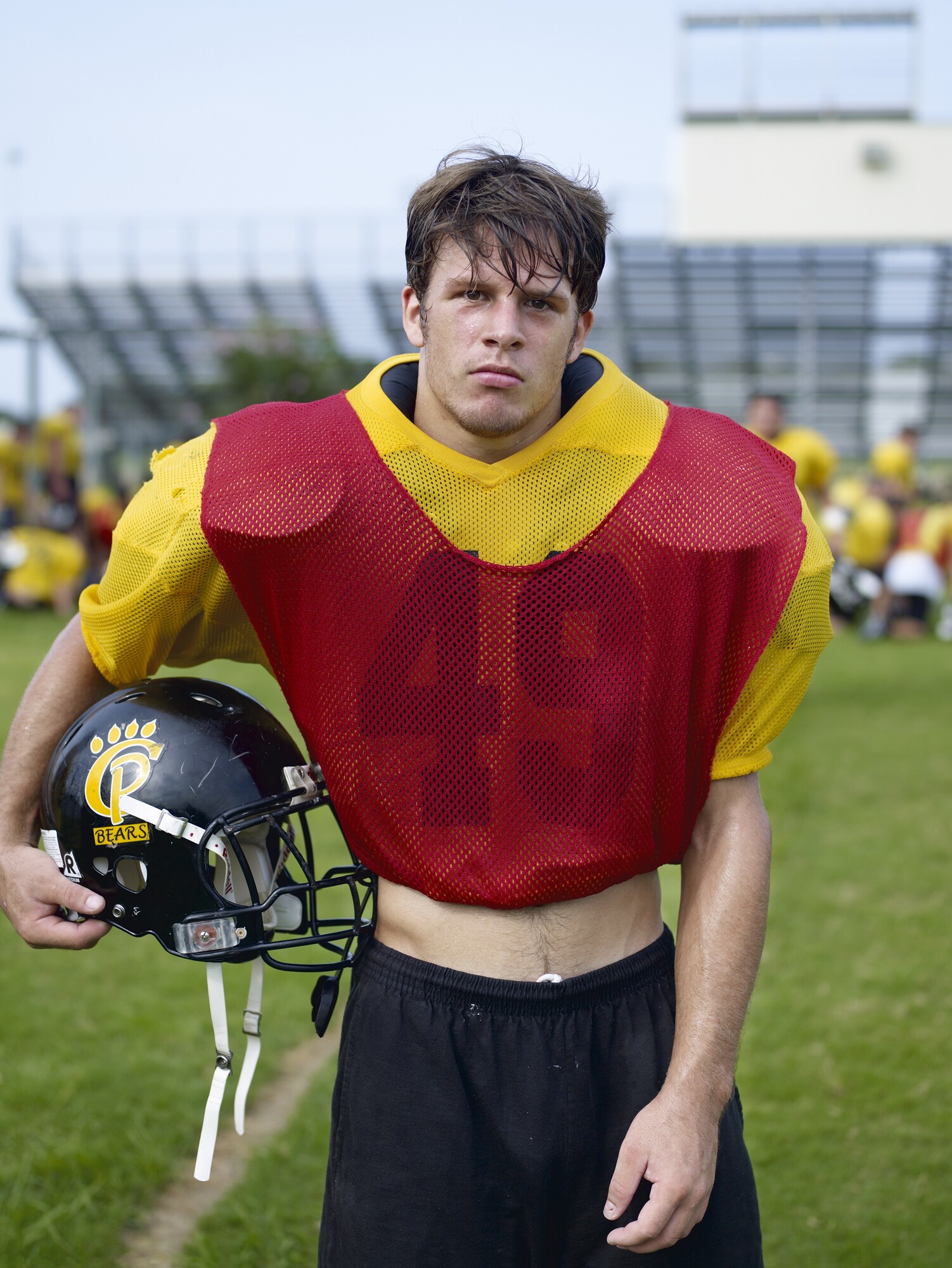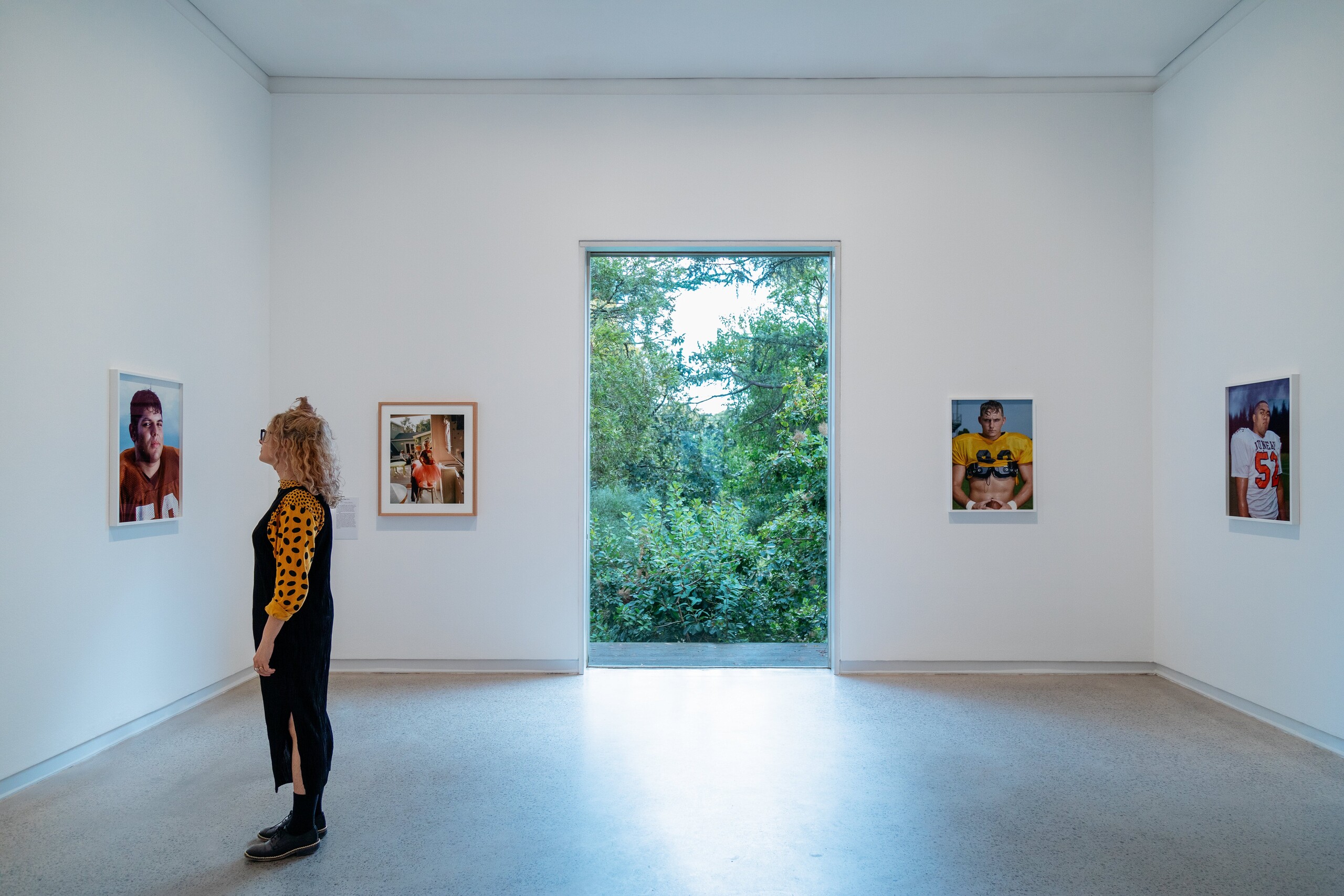Catherine Opie: Binding Ties
Chelsea Hopper
What is Catherine Opie doing back in Australia? In 1994, eighteen of her photographs were included in a group exhibition curated by Juliana Engberg at none other than Heide. Titled Persona Cognita, Opie’s work sat amongst fifteen other artists (Jill Orr, Gareth Samson, Julie Rrap, to name a few) and reappeared in 1999, when Engberg also included her in the Melbourne International Biennial 1999. Over the next twenty-four years, Opie’s work would barely be seen in Australia. Only six of her works have been acquired by Australian institutions (two by the Art Gallery of New South Wales and four by the Art Gallery of Western Australia). Back at Heide, three decades later, Catherine Opie: Binding Ties, curated by Brooke Babington, is the artist’s first major survey show in Australia—long overdue for one of the most internationally celebrated American photographers of our time.
The exhibition is a mix of fifty works from a range of series made between 1993 and 2020. It begins with six large-scaled studio portraits from the ongoing series Portraits and Landscapes, four of which are presented in large black oval frames. Beginning in 2012, the series documents sitters whom Opie includes in every body of work, and evidently admires, along with prominent People of Colour, queer folk, artists, and friends. We see her long-term collaborator Pig Pen (aka Stosh Fila), for example, kissing their partner, performance artist Julie Tolentino. Other sitters include established American artist Kara Walker; Rocco Kayiatos, who co-founded Original Plumbing, an important early cheeky quarterly mag for trans men; and a power couple—museum curator Thelma Golden standing next to her husband, fashion designer Duru Olowu.

Adopting the dark contrasts of chiaroscuro characteristic of Old Masters painting, these Baroque-esque portraits emphasise the subject’s gaze, which is often averted from the camera. The tender portrait of Opie’s then ten-year-old son, Oliver, with his pet mouse Mrs Nibbles, hung across the room, is modelled after Leonardo da Vinci’s Lady with an Ermine (ca. 1489—1491). Opie adopts the style and formal language of classical portraiture to engage with and interrogate the ways in which the history of art and representation have attributed or denied subjectivity through the genre. And yet the subjects Opie includes in the series are also greatly celebrated in their own disciplines and privileged in their social status position within the art world, at least. As such, the series celebrates a new canon of elevated subjects, a renegotiating of classical portraiture’s construction of social class.

Sitting opposite Portraits and Landscapes is the most recent series in the exhibition titled monument/monumental (2020). This series has its roots in a six-week road trip Opie took from Los Angeles to Virginia during the Covid pandemic. Bar one, each photograph depicts scenic views of waterfalls, sunsets, lakes, and mountain ranges, all intentionally out of focus. I am reminded of an earlier series, 700 Nimes Road (2016), in which Opie photographed Elizabeth Taylor’s Bel-Air home (Taylor died mid-way through the project), documenting her possessions and private spaces. Several photographs from this series of Taylor’s jewellery are also out of focus. Here “out of focus” represents an appropriation of photographic Pictorialism, especially its use of fuzzy, soft focus and manipulated lighting that aimed to align photography with painting. The soft focus is code for an autographic vision of photography, in which the subjectivity and “hand” of the photographer, here Opie, is marked on the surface of the photograph.
In a 2019 interview Opie remarked, “Having Elizabeth Taylor sit for me would’ve been fine, but it wouldn’t have told anybody anything.” Could the same be said for these landscapes? Do they “work on the level of metaphor to gesture toward questions about land, its history and ownership,” as the wall label suggests? Or do they counteract what is in focus? The central, focussed photograph is emphasised: a monument Opie encountered in Charlottesville, Virginia, of Robert E. Lee, the Civil War—era Confederate general atop a horse. The statue was removed from public space in 2021 and relocated to the Black History Museum and Cultural Center of Virginia.

This location, so laden with associations of Confederate history and white power, became a counter-monument for the Black Lives Matter movement during the 2020 protests, whose resistance is marked by the graffiti that densely covers the statue’s pedestal (which was finally removed in February 2022). Displayed at Heide, the image cannot help but conjure the histories of colonial violence and genocide shared by the United States and Australia. We need only look to the campaigns for the removal of a bronze statue of colonial figure William Crowther in nipaluna/Hobart, the protests and petitions surrounding Thomas Woolner’s statue of James Cook at Hyde Park, or the dousing in pink and red paint of St Kilda’s Captain James Cook monument. And yet, the exhibition leaves us wondering what Opie’s work is actually, actively saying about these inter-colonial resonances of conquest and concession.

The monument/monumental series can also be read as a queering of the landscape. The works literally blur a “straight” vision of photography. Their fuzziness (which can be seen as either a “defect” or an aesthetic strategy) suggests a “third space” (both social or political) that provokes notions of safety, access, and equity. It returns us to photography’s early pictorialism, while also demonstrating how its values and different functions, like queerness, change over time. As with Taylor’s obfuscated jewellery, queer communities have long been kept out of focus (or in focus for wrong reasons), underrepresented, and increasingly subjected to ongoing violence in public spaces. Queerness is ubiquitous in Opie’s practice. Here, she creates a visual space for queer identity to exist outside of the scrutiny generated by the scrutiny of focus.

If this series is about obfuscation, others traffic clearly in the politics and language of visibility. This is also why Opie is renowned for her 1990s portraits of members of queer, transgender, drag, kink and leather-culture communities in Los Angeles and San Francisco. A selection of photographs from the Portraits series (1993–97) are hung around the main gallery space, documenting sitters Idexa, Mitch, James, Crystal, Alistair, Mike, and Sky. Each pose in front of Opie’s distinctive, richly coloured backdrops that echo Hans Holbein portraits (another stylistic technique the artist still uses today). These portraits are especially seductive, partly due to the chromogenic printing process, which produces sharp images and vibrant colours. These lush, intimate portraits, as queer theorist Jack Halberstam noted in 1998, “put a particular version of female masculinity on display … each portrait adds a new gender dimension not admissible to the binary of ‘female’ or ‘male’.” The fake moustache in Opie’s self-portrait Bo (1994) and the cropped haircut in her highly celebrated Self Portrait/Cutting (1993) are exemplary of these unambiguous, resolute images of her subjects’ performed identities. Does this ’90s queer reading retain its currency today, in an era where queer culture has been assimilated by mainstream culture?

Across the main gallery space is a stand-out portrait of Robert Blanchon, a talented American conceptual artist who died in 1999 from AIDS-related complications, three years after the photograph was taken. In a 2006 interview with writer Nicole Pasulka, Opie stated that “the project was about recording a community that was disappearing because my friends were dying of AIDS.” For Opie, it was also about “documenting the architecture of the queer community.” In this community, the architecture, as Opie reiterates to us, “appears on the body,” like Blanchon’s flame tattoo above his belly button or the harsh tan lines above his unbuttoned jean loops.
Hanging immediately behind Blanchon’s portrait on the other side of the wall is a youthful portrait of Pig Pen, who we also see in a more recent video work, The Modernist (2016), projected in a separate room. Pig Pen (1993) is mixed up with another series, capturing a community of high school footballers and Oliver in a Tutu (2004)—Opie’s son standing barefoot on a stool in a beautifully sunlit laundry dressed in pink tulle and an oversized football jersey.

In one picture, an adolescent teen Josh (2007), who somehow looks exactly like someone who would be called Josh, stares back at us, gripping a football, drenched in sweat. Other teens appear on the precipice of gaining muscle mass, incredibly toned or in the midst of dealing with acne—all privy to and documenting adolescent transition. The Footballers, much like The Surfers series found wrapped around an adjacent room, subtly refers to the creation of temporary communities that cut through the social divisions of our physical and cultural landscape.

It was John Berger who said that “photography, because it preserves the appearance of an event or person, has always been closely associated with the idea of the historical.” Opie’s entire project is about what it means in historical terms to take a photograph of something that is ephemeral or mutable, and inevitably queerness pervades regardless of subject matter. In the context of her exhibition here in Melbourne, Opie’s photographs question Australia’s vocabulary of American iconography, of what we think we know about it and what we are asked to look at again. I return to my first question—what is Catherine Opie doing back here? The exhibition doesn’t try to highlight parallels between Australian and American political struggles, whether anti-racist or queer, and is complicated by the nature of its non-chronological hang and disparate wall labels—which challenges us as viewers to make our own connections, and thus leaves the question resolutely unanswerable. Welcome back, Cathy.
Chelsea Hopper is a curator, writer, and contributing editor at Memo. In 2022, she ran 99%, a populist gallery housed in the Nicholas Building.


